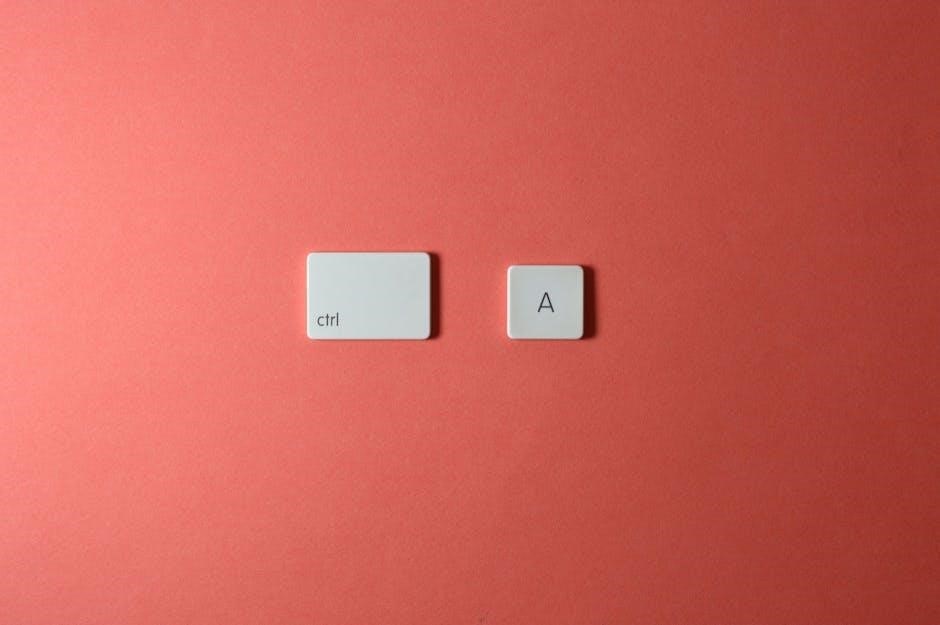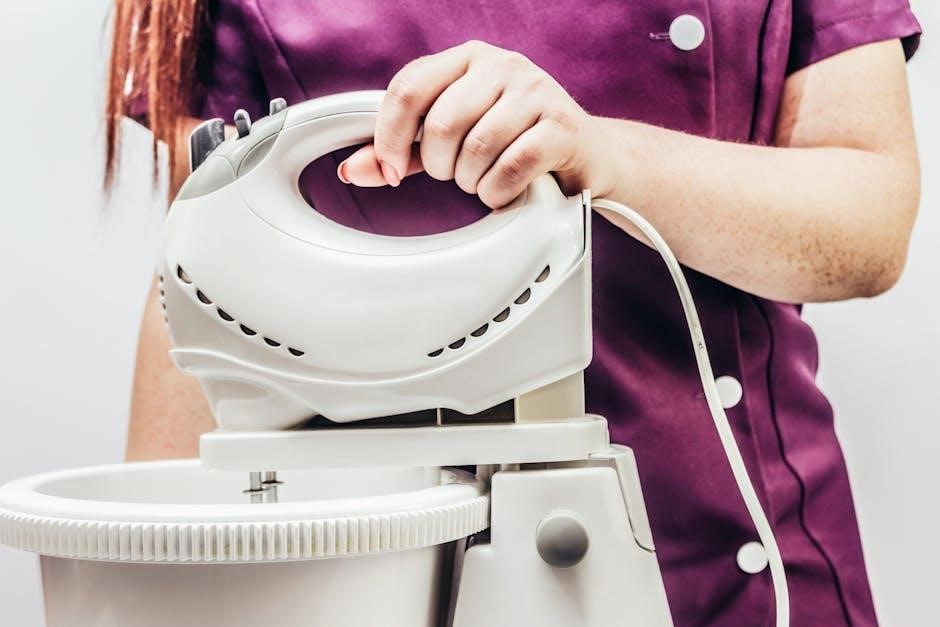Welcome to the Bosch Washer Instruction Manual, your comprehensive guide to understanding and operating your washing machine effectively. This manual covers essential safety precautions, installation steps, operational guidelines, and troubleshooting tips to ensure optimal performance and longevity of your appliance.
1.1 Importance of Reading the Manual
Reading the Bosch Washer Instruction Manual is essential for safe and efficient use of your appliance. It provides critical information on safety precautions, proper installation, and optimal operation. Understanding the manual ensures you utilize all features correctly, maintain the washer’s performance, and troubleshoot common issues. Additionally, it helps prevent accidents, protects your warranty, and guides you in maintaining the appliance for long-term durability. Always refer to the manual before attempting any repairs or adjustments to ensure compliance with manufacturer guidelines and safety standards.
1.2 Safety Precautions
Reading the manual is crucial for understanding safety guidelines. Never use a damaged appliance or install it improperly. Keep the manual accessible for future reference. Ensure children cannot access the washer unattended, as it may pose a hazard. Follow all safety instructions to prevent accidents and ensure proper functionality. Avoid stacking appliances from different manufacturers, as this can compromise stability. Always adhere to the manufacturer’s guidelines to maintain safety and prevent potential risks associated with improper use or installation.
1.3 Key Features of Bosch Washers
Bosch washers are known for their innovative design and energy efficiency. They offer multiple wash cycles, including eco modes, to cater to different fabric types and reduce energy consumption. Advanced features like quiet operation and smart integration enhance user convenience. The washers also include child safety locks and durable construction for long-term reliability. Regular maintenance, such as cleaning the detergent drawer and checking filters, ensures optimal performance. These features make Bosch washers a practical and eco-friendly choice for households seeking high-quality laundry solutions.

Safety Instructions
Adhere to safety guidelines to ensure safe operation. Read the manual thoroughly, as improper use can lead to hazards. Always inspect the washer for damage before use.
2.1 General Safety Information
Reading this manual carefully is crucial for safe and proper use of your Bosch washer. Always follow the instructions and safety guidelines provided to avoid accidents. Ensure the appliance is installed correctly and not damaged during transit. Never operate the washer if it is damaged or malfunctioning. Keep the manual safe for future reference or for the next owner. Familiarize yourself with the washer’s features and controls before use. Adhere to all safety precautions to ensure optimal performance and longevity of your Bosch washing machine.
2.2 Intended Use of the Washer
Your Bosch washer is designed exclusively for washing and rinsing clothes and fabrics in a domestic setting. It is not intended for industrial or commercial use. Always use the washer for its designated purpose, as outlined in this manual. Do not use it for drying clothes or as a dryer, as this could damage the appliance or pose a safety risk. Ensure that all fabrics being washed are suitable for machine washing. Adhere to the guidelines provided to maintain optimal performance and ensure safe operation.
2.3 Child Safety Features
Your Bosch washer is equipped with child safety features to ensure safe operation and prevent accidents. The child-proof lock prevents unintended access or accidental start, while stable construction reduces tipping risks. Always supervise children near the washer and teach them to avoid playing with controls. Keep children away from moving parts and ensure they understand the dangers of interfering with the appliance. Regularly check for any wear or damage to safety features. By adhering to these guidelines, you can create a safer environment for your family while maintaining your washer’s functionality and efficiency.

Understanding Your Bosch Washer
Get acquainted with your Bosch washer’s design, key components, and advanced features designed for efficient and gentle laundry care. This section helps you understand its operation and capabilities.
3.1 Description of the Washer
Your Bosch washer is designed with innovative technology for efficient and gentle laundry care. Featuring a sleek, modern design, it offers advanced control panels, multiple wash cycles, and large capacity options. The washer includes eco-friendly modes, quiet operation, and durable construction. Models like the WGG254Z0GB boast 10KG capacity and 1400 spin speed, ensuring superior cleaning performance. With customizable settings and energy-saving features, Bosch washers cater to diverse laundry needs while maintaining high standards of quality and reliability.
3.2 Identifying Your Washer Model
To identify your Bosch washer model, locate the E-NR (model number) on the rating plate or sticker, typically found on the machine’s interior or rear; This number is essential for accessing specific manuals, troubleshooting, and support. For example, models like WGG254Z0GB or WFK 2401 indicate unique features and capacities. Referencing this number ensures you receive accurate information and compatibility with official Bosch resources, such as user manuals or authorized service providers, tailored to your exact appliance.
3.3 Key Components and Controls
Familiarize yourself with your Bosch washer’s key components, such as the control panel, detergent drawer, and display. The control panel features buttons for cycle selection, temperature, and spin speed. The detergent drawer is divided into compartments for pre-wash and main wash doses. The display screen shows cycle progress, settings, and error codes. Additional controls may include buttons for EcoMode, child lock, and delayed start. Understanding these components ensures efficient operation and customization of your washing experience. Refer to your model’s manual for specific features and configurations.

Installation and Setup
Proper installation ensures optimal performance. Unpack carefully, level the washer, and connect water and power supplies. Follow manual instructions for initial setup and configuration.
4.1 Pre-Installation Checks
Before installing your Bosch washer, perform essential checks. Ensure the site is level and stable to prevent vibration. Verify water supply lines are undamaged and compatible with the machine. Check electrical connections meet voltage requirements. Ensure sufficient space for proper ventilation and access. Review the manual for specific model recommendations. Inspect the washer for transit damage and ensure all parts are included. Proper preparation ensures smooth installation and optimal performance. Follow all safety guidelines to avoid potential hazards during setup.
4.2 Installing the Washer
Place the Bosch washer on a level, stable surface to ensure balance and prevent vibration. Connect the water supply lines securely to the machine and water source, avoiding leaks. Plug the power cord into a grounded outlet matching the washer’s voltage requirements. Attach the drain hose to a nearby standpipe or laundry tub, ensuring proper elevation. Follow the manual for specific model instructions. Tighten all connections firmly and test the machine with a short cycle to verify functionality. Ensure all installations comply with safety standards for optimal performance and longevity.
4.3 Initial Setup and Configuration
After installation, configure your Bosch washer according to your preferences. Select the appropriate language and time zone using the control panel. For smart models, enable Wi-Fi connectivity to access advanced features via the Bosch Home Connect app. Set the water hardness level based on your local water supply. Check and activate child safety locks if needed. Run a test cycle without laundry to ensure proper function. Refer to the manual for model-specific settings, such as eco-mode activation or customizing wash programs. Complete these steps to optimize performance and tailor the washer to your needs.

Operating the Bosch Washer
Operate your Bosch washer by selecting the appropriate wash cycle, adding detergent, and starting the machine. Ensure correct laundry loading and detergent dosage for optimal results. Always refer to the manual for specific cycle details and customization options to achieve the best cleaning performance.
5.1 Control Panel Overview
The control panel is the central interface for operating your Bosch washer. It features a user-friendly design with buttons, knobs, and a display screen. Use the panel to select wash cycles, adjust temperature settings, and customize options like spin speed and soil level. The display screen shows the selected settings, remaining cycle time, and error codes. Familiarize yourself with the controls to optimize laundry results. Refer to the manual for detailed instructions on using each function effectively. Proper use ensures efficient and safe operation of your Bosch washing machine.
5.2 Loading Laundry
Properly loading your Bosch washer ensures efficient cleaning and prevents damage. Always check fabric care labels for specific instructions. Separate delicate and heavy items to avoid damage. Do not overload the drum, as this can reduce wash performance and cause imbalance. Place items gently to avoid tangling or stretching. Ensure the laundry is evenly distributed and the drum is not packed too tightly. For optimal results, balance bulky items with smaller ones. Avoid adding excessive detergent, as this can affect rinse performance and leave residue. Refer to the manual for load capacity guidelines specific to your model.
5.3 Adding Detergent
Adding the right amount of detergent is crucial for optimal wash performance. Locate the detergent drawer, typically found on the top right of the control panel. Pour the recommended dose of detergent into the main compartment. For pre-treatment or fabric softeners, use the designated sections. Refer to the detergent packaging and your Bosch manual for dosage guidelines. Avoid overloading, as excess detergent can leave residue and affect rinse efficiency. Ensure the drawer is securely closed before starting the cycle. Cleaning the detergent drawer regularly is also recommended to maintain hygiene and performance.
5.4 Selecting Wash Cycles
Selecting the right wash cycle ensures optimal cleaning and fabric care. Use the touch control panel to choose from pre-set cycles like Cotton, Synthetic, or Delicate, based on the fabric type and load size. For heavily soiled items, select the Intensive Wash option. For delicate fabrics, choose the Gentle or Wool cycle. Always check the care label on your garments for specific cycle recommendations. Once selected, press the Start button to begin the cycle. Refer to your Bosch manual for detailed descriptions of each cycle to ensure the best results for your laundry.
5.5 Starting the Wash Cycle
Once the detergent is added and settings are configured, press the Start button to begin the wash cycle. A confirmation beep will sound, and the washer will lock the door. The display will show the selected cycle and estimated remaining time. Let the machine complete the cycle without interruption. If the load is unbalanced, the washer may delay start to redistribute clothes. Allow the cycle to finish to ensure proper cleaning and rinsing of your laundry.
Maintenance and Care
Regular maintenance ensures optimal performance. Clean the detergent drawer, check and clear filters, and wipe the exterior. Follow the manual for detailed care instructions.
6.1 Cleaning the Detergent Drawer
Cleaning the detergent drawer is essential for maintaining your washer’s performance. Remove the drawer, rinse it under warm water, and check for residue. Ensure it is dry before reinstalling to prevent mold or odor buildup. Regular cleaning helps prevent detergent clogs and ensures optimal dosing. Refer to your manual for specific instructions on removing and reinstalling the drawer. Proper maintenance ensures efficient detergent use and fresh laundry outcomes.
6.2 Checking and Cleaning the Filter
Regularly inspect and clean the filter to ensure optimal performance and prevent clogs. Locate the filter, typically at the bottom of the washer. Turn off the machine, unplug it, and place a container under the filter to catch water; Remove the filter, rinse it under running water, and check for debris. Replace the filter securely after cleaning. This maintenance step prevents poor drainage and ensures efficient washing cycles. Clean the filter every 1-2 months or as needed, depending on usage. Refer to your manual for model-specific instructions.
6.3 Caring for the Washer Exterior
Regular cleaning is essential to maintain the hygiene and appearance of your Bosch washer. Use a soft, damp cloth to wipe down the exterior, avoiding abrasive materials that could scratch the surface. Avoid using harsh chemicals or bleach, as they may damage the finish. For stubborn stains or marks, dilute a mild detergent in water and gently scrub the area. Rinse thoroughly with a clean cloth to remove any residue. Regularly cleaning the exterior ensures long-term performance and keeps your washer looking like new. Always dry the surface after cleaning to prevent water spots.
6.4 Regular Maintenance Tasks
Performing regular maintenance ensures your Bosch washer operates efficiently and lasts longer. Check and clean the detergent drawer monthly to prevent residue buildup. Leave the washer door open after use to dry the interior and prevent mold. Run a cleaning cycle with a washer cleaner every 1-2 months to remove debris. Check the drain pump filter regularly and clean it as needed. Ensure the washer is level to prevent vibration and noise. These simple tasks help maintain performance, hygiene, and extend the lifespan of your appliance. Always refer to your manual for specific maintenance recommendations.

Troubleshooting Common Issues
Refer to this section for solutions to common problems, error codes, and resetting procedures. Consult the manual for detailed guidance on addressing specific washer issues effectively.
7.1 Common Problems and Solutions
Common issues with Bosch washers include improper drainage, noisy operation, or failure to start. Check the filter for blockages and ensure the detergent drawer is clean. If the washer doesn’t start, verify power supply and door alignment. For noise, inspect for loose items or imbalance. Refer to the manual for solutions or reset the washer by unplugging it for 30 minutes. Regular maintenance, like cleaning filters and checking hoses, prevents many issues. Always follow troubleshooting steps in the manual before contacting support.
7.2 Error Codes and Their Meanings
Bosch washers display error codes like E01, E02, or E03 to indicate specific issues. E01 often relates to water supply problems, while E02 may signal a temperature sensor malfunction. E03 could indicate a motor issue. Refer to the manual for a full list of codes and their meanings. Understanding these codes helps diagnose problems quickly, such as checking water supply lines for kinks or ensuring proper detergent use. Addressing these issues promptly prevents further damage and ensures smooth operation. Always consult the manual or contact support if unsure.
7.3 Resetting the Washer
To reset your Bosch washer, unplug it from the power source for 30 minutes to reset the electronic controls. Plug it back in and run a test cycle. This process often resolves issues like error codes or unexpected pauses. Ensure the washer is empty during resetting. If problems persist, consult the manual or contact Bosch support. Resetting helps clear minor glitches but should not be overused, as persistent issues may indicate a deeper malfunction requiring professional attention.

Energy Efficiency and Eco Modes
Bosch washers are designed with energy efficiency in mind, offering eco modes to reduce consumption. Select lower temperature cycles and use eco settings to save energy effectively.
8.1 Energy-Saving Features
Bosch washers incorporate advanced energy-saving features such as EcoModes and low-power consumption cycles. These technologies help reduce energy usage while maintaining superior cleaning performance. The EcoMode option optimizes water and energy consumption during wash cycles. Additionally, Bosch’s ActiveWater system efficiently manages water usage, ensuring minimal waste. By utilizing these features, users can significantly lower their energy bills and contribute to environmental sustainability. Bosch’s commitment to energy efficiency ensures that its washers meet high standards of eco-friendliness without compromising on wash quality.
8.2 Using Eco Modes Effectively
Bosch washers offer EcoModes designed to optimize energy and water usage. For best results, use EcoMode for lightly soiled laundry to reduce energy consumption. This mode extends wash cycles but uses less water and energy, making it ideal for everyday loads. Regularly using EcoMode can significantly lower your energy bills and environmental impact. Combine EcoMode with Bosch’s ActiveWater technology for enhanced efficiency. Always follow the recommended guidelines for detergent dosage to maximize EcoMode benefits and ensure optimal cleaning performance while saving resources.
8.3 Reducing Energy Consumption
Bosch washers are designed with energy efficiency in mind. To reduce consumption, use EcoMode for lightly soiled laundry, as it lowers energy use while maintaining performance. Selecting lower temperature cycles and avoiding overloading the drum also helps conserve energy. Regularly cleaning the filter ensures optimal operation. For advanced models like the WFK 2401, energy-saving features automatically adjust water and power usage. By following these tips, you can minimize your washer’s energy footprint while keeping your clothes clean and extending the appliance’s lifespan.

Warranty and Support
Bosch offers comprehensive warranty coverage for its washers, ensuring protection against defects. Register your appliance on MyBosch for enhanced benefits and personalized support. For assistance, contact Bosch customer service or visit their official website for troubleshooting guides and authorized service providers.
9.1 Understanding Your Warranty
Your Bosch washer warranty provides coverage against manufacturing defects for a specified period. The warranty typically includes parts and labor, ensuring repairs or replacements are free of charge. Registration on MyBosch may be required to activate or extend warranty benefits. Review your warranty document for terms, conditions, and exclusions. Keep your purchase receipt and model number handy for warranty-related inquiries. Bosch’s dedicated support team is available to assist with any warranty claims or questions you may have.
9.2 Contacting Bosch Support
For assistance with your Bosch washer, visit the official Bosch website and navigate to the support section. Enter your appliance’s model number (E-Nr) to access tailored help. You can contact Bosch support via phone, email, or live chat for troubleshooting, repairs, or general inquiries. Additionally, the website offers downloadable manuals, FAQs, and troubleshooting guides to address common issues independently. Bosch’s customer service team is available to provide expert guidance and ensure your appliance operates at its best. Always have your model number ready for efficient support.
9.3 Finding Authorized Service Providers
To locate an authorized Bosch service provider, visit the official Bosch website and navigate to the “Support” section. Enter your appliance’s model number (E-Nr) to find certified technicians in your area. Bosch-authorized service providers ensure genuine parts and expert repairs. You can also contact Bosch customer service for recommendations or use the website’s service locator tool. Always verify the provider’s authorization to guarantee warranty compliance and reliable service. This ensures your washer receives proper care and maintains its performance and longevity.

Technical Specifications
Discover detailed dimensions, energy consumption, spin speed, and capacity of your Bosch washer. These specs ensure optimal performance and help in making informed decisions for your laundry needs.
10.1 Dimensions and Weight
Ensure your Bosch washer fits perfectly in your space by checking its dimensions and weight. Standard models typically measure around 850mm in height, 598mm in width, and 590mm in depth. The weight varies between 60-80kg, depending on the model and features. Always refer to your specific model’s manual for precise measurements to ensure proper installation and placement. This information is crucial for planning your laundry area and ensuring the washer is level and stable during operation.
10.2 Energy Consumption Details
Bosch washers are designed with energy efficiency in mind, offering low power consumption while maintaining high performance. Typically, models operate within an energy rating of A+++ to A++, consuming approximately 0.9 to 1.2 kWh per cycle. Exact energy usage depends on the selected wash program, load size, and eco-mode activation. Refer to your specific model’s manual for precise energy consumption details, ensuring optimal energy-saving performance tailored to your needs.
10.3 Spin Speed and Capacity
Bosch washers offer varying spin speeds and capacities to suit different laundry needs. Most models feature spin speeds ranging from 1,000 to 1,600 RPM, ensuring efficient water removal. Capacities typically range from 7kg to 10kg, allowing for both small and large loads. Higher capacity models are ideal for bulky items, while variable spin speeds help reduce moisture content, promoting faster drying times. Refer to your specific model’s manual for exact specifications to optimize performance for your laundry requirements.

Additional Resources
Explore online manuals, guides, and FAQs for your Bosch washer. Visit the official Bosch website or authorized retailers for model-specific documentation and customer support assistance.
11.1 Online Manuals and Guides
Access comprehensive online manuals and guides for your Bosch washer by visiting the official Bosch website or authorized retailers. These resources provide detailed instructions, troubleshooting tips, and model-specific information to help you optimize your appliance’s performance. Simply enter your washer’s model number (E-Nr) to download PDF manuals, installation guides, and user instructions. Additionally, find FAQs, energy consumption details, and maintenance tips to ensure your washer operates efficiently. These online resources are designed to help you understand and maintain your Bosch washer effectively, addressing common issues and enhancing your overall user experience.
11.2 Bosch Customer Service
Bosch offers dedicated customer service to assist with any inquiries or issues regarding your washer. Visit the official Bosch website to access contact information, including phone numbers and email support. You can also register your appliance on the MyBosch platform for personalized assistance and updates. Bosch customer service provides troubleshooting guidance, repair service scheduling, and warranty information. Their team is available to address concerns, ensuring your washing machine operates efficiently. For further support, explore the FAQs and resources available on their website, designed to help you make the most of your Bosch washer.
11.3 Frequently Asked Questions
The FAQ section addresses common queries about Bosch washers, such as error codes, detergent usage, and noise issues. It provides solutions for troubleshooting and maintenance tips to ensure optimal performance; Topics include understanding wash cycles, resolving drainage problems, and interpreting error messages. Additionally, FAQs cover energy efficiency, eco-mode benefits, and proper loading techniques. This resource helps users quickly find answers to everyday concerns, ensuring their Bosch washer operates smoothly. Referencing your model number can also provide more specific guidance tailored to your appliance.

